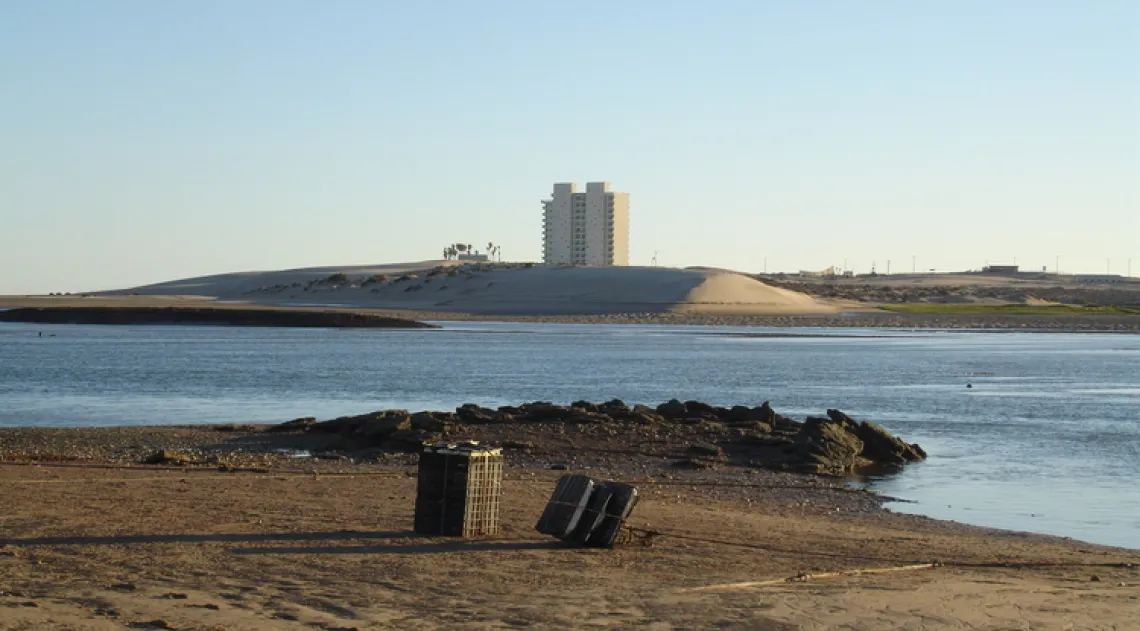UA Researchers Take a Closer Look at the Future of Desalination

As a variety of factors are expected to increase water scarcity throughout the Southwest region, several states, including Arizona, are considering plans to partner with Mexico to build binational desalination plants.
 Having investigated the potential impacts of binational desalination systems, which are arrangements in which desalted water is produced in one country and delivered or exchanged with another country, a group of University of Arizona researchers, along with colleagues from universities in Mexico, published "Desalination and water security in the US-Mexico border region: assessing the social, environmental and political impacts."
Having investigated the potential impacts of binational desalination systems, which are arrangements in which desalted water is produced in one country and delivered or exchanged with another country, a group of University of Arizona researchers, along with colleagues from universities in Mexico, published "Desalination and water security in the US-Mexico border region: assessing the social, environmental and political impacts."
The article exploring desalination, a technological process that removes salts and other minerals from seawater, creating freshwater, was published in Water International.
Even though desalination remains the most expensive water option on the table, its allure continues to increase, especially since costs have decreased by about 50 percent in the last decade, said lead author Margaret Wilder, an associate professor in the UA School of Geography and Development and the Center for Latin American Studies.
Wilder said that she and her colleagues felt they needed to write the paper because desalination is often presented by agencies as an inevitability, but that desalination needs to be examined more critically beyond a simple cost-benefit analysis. Some use terminology such as "It's an endless water supply," and "It's a drought-free water supply," Wilder explained. However, political, social, economic and environmental implications must also be assessed.
Wilder's co-authors include UA colleagues Robert Varady, Robert Merideth and Adriana A. Zúñiga-Terán, researchers with the Udall Center for Studies in Public Policy; Sharon Megdal, director of the Water Resources Research Center; and Christopher Scott, professor in the School of Geography and Development and the Udall Center. Other authors are Ismael Aguilar-Barajas, professor at Tecnológico de Monterrey; Nicolás Pineda-Pablos, professor at El Colegio de Sonora; and Jamie McEvoy, a former graduate student from the UA School of Geography and Development who is now an assistant professor at Montana State University.
The team conducted a case study of a proposed desalination plant on the Mexican coast of the Gulf of California in Puerto Peñasco, Sonora. Wilder, along with Pineda-Pablos, Varady, McEvoy and Scott, researched the proposed plant by interviewing water managers, conducting archival research and holding a workshop with local and state stakeholders. The research was funded by a grant from the National Oceanic and Atmospheric Administration. The work was also supported by the Puentes Consortium of border universities, headquartered at Rice University.
Wilder says that efficiency is a concern, as about 40-50 percent of the water is "lost" in the delivery system in Mexico compared to about 5 percent in the U.S. Improving efficiency, re-using water and other "soft-path" alternatives should be employed before turning to desalination. In addition, although the U.S. and Mexico have a recent history of amicable water sharing, relying on another country for water depends on sustained cooperation.
"This would hook us into path dependency," Wilder said. "Can we count on robust and sustained good relations between Mexico and the U.S., as we have had in the last 30 years, over water?"
One reason for building a plant in Mexico is that the U.S. already has the conveyance system to transport the water from Mexico to the U.S. due to the infrastructure already in place to make water deliveries to Mexico and to distribute Central Arizona Project water to cities. Environmental regulations are stricter in the U.S., as well. Wilder believes it would be cheaper to build and run the plant in Mexico.
The desalination process is energy intensive, resulting in greenhouse gas emissions. Reverse osmosis uses approximately 10 times more energy than traditional treatment of an equal volume of surface water.
But Wilder said the biggest environmental concern is the large amount of brine concentrate created in the desalination process. The most common disposal method of concentrated brine is dispersal back into the ocean, which has an unknown impact on marine and terrestrial ecosystems.
Speaking specifically about the proposed plant in Puerto Peñasco, Wilder said "the Upper Gulf of California is an extremely biodiverse environment; it has a lot of species so the environmental impact is extremely worrying. We are talking about over 16 million gallons of brine concentrate per day potentially pumped into the Gulf."
In addition to fragile and protected ecosystems being affected, the plant would impact the local communities, raising the question of how and whether Mexico would benefit from the arrangement.
Local Mexican communities would likely benefit from the increasing water supply, although the authors raised the prospect of unsustainable growth. Job creation, both in the desalination plant and in the growing tourism industry as a consequence of more water, might offset the loss of fisheries-related jobs. However, much of the area's tourism business is related to the biodiversity of the Upper Gulf.
Wilder emphasizes that the article should not be viewed as an opposition to desalination, but rather as a call for transparent and accountable assessment of desalination and its alternatives.
"I think most of us feel it is going to happen at some point," Wilder said. "But is it going to happen on the coast of Mexico? Is it going to happen with protection for the environment and with social protections so that we are not growing unsustainably?"

